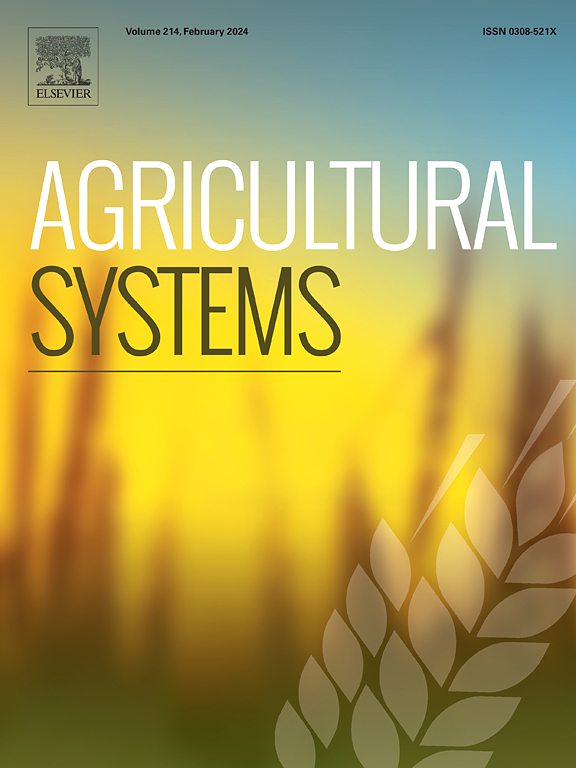A machine learning approach to simulate cattle growth at pasture using remotely collected walk-over weights
IF 6.1
1区 农林科学
Q1 AGRICULTURE, MULTIDISCIPLINARY
引用次数: 0
Abstract
Context
The growing interest in the use and implementation of remote and automated technologies, such as walk-over (WO) weighing, has made the availability of a large volume of data. However, animal behaviour, sensitivity and repeatability of WO weighing scales and animal's physiological state could impact the accuracy of recorded weights. Therefore, WO weight data needs through processing before it can be utilized effectively for developing livestock management tools.
Objective
This study is designed to implement a machine learning (ML) approach to develop a simulation model capable of predicting cattle growth using remotely collected WO weight data from pasture-based beef production.
Methods
WO weight data collected from two beef production farms (Belmont and Tremere) of central Queensland, Australia has been used to train an XGBoost ML model which is then implemented in an algorithm that takes the number of male and females of Belmont Red, Brahman, Composite and unknown breed of animals, number of days to simulate, birth date range of animals and weather conditions at the farm to simulate as input parameters and predicted daily weights as the output.
Results and conclusions
The simulation model obtained Lin's concordance coefficient (CCC), root mean square error (RMSE), mean absolute percentage error (MAPE) and coefficient of determination (R2) of 0.84, 32.60 kg, 15.23 % and 0.77 respectively for test set 1 and CCC, RMSE, MAPE and R2 of 0.82, 38.30 kg, 15.20 %, and 0.73 respectively for test set 2, when compared with the actual WO weights. The mean difference between the simulated and observed weights is found to be −1.2 kg (SD 27.3 kg), where the 95 % agreement limit (at 1.96 SD) is −54.8 kg to 52.3 kg.
Significance
The results suggest that autonomously collected WO weights can be an important data source for developing strategies for livestock management, and the simulation model developed in this study can be used by cattle producers to predict the growth patterns of their herd and by researchers to generate cattle growth data to implement in the development of livestock managements tools.

一种机器学习方法,通过远程收集行走重量来模拟牧场上牛的生长
人们对远程和自动化技术的使用和实施越来越感兴趣,例如移动(WO)称重,这使得大量数据变得可用。然而,动物行为、体重秤的灵敏度和可重复性以及动物的生理状态都会影响体重记录的准确性。因此,WO权重数据需要经过处理,才能有效地用于开发牲畜管理工具。本研究旨在实现机器学习(ML)方法,开发一个模拟模型,该模型能够使用远程收集的牧场牛肉生产的WO体重数据来预测牛的生长。方法从澳大利亚昆士兰州中部的两个牛肉生产农场(Belmont和Tremere)收集的swo体重数据用于训练XGBoost ML模型,然后在一种算法中实现该模型,该算法将Belmont Red、Brahman、Composite和未知品种的雄性和雌性数量、要模拟的天数、动物出生日期范围和要模拟的农场的天气条件作为输入参数,并将预测的每日体重作为输出。结果与结论与实际WO权重相比,模拟模型得到的测试集1的林氏一致性系数(CCC)、均方根误差(RMSE)、平均绝对百分比误差(MAPE)和决定系数(R2)分别为0.84、32.60 kg、15.23%和0.77,测试集2的CCC、RMSE、MAPE和R2分别为0.82、38.30 kg、15.20%和0.73。模拟和观察到的重量之间的平均差异为- 1.2 kg(标准差27.3 kg),其中95%的一致性限制(在1.96标准差处)为- 54.8 kg至52.3 kg。结果表明,自主收集的WO权重可以成为制定牲畜管理策略的重要数据源,本研究建立的模拟模型可以用于牛生产者预测其牛群的生长模式,也可以用于研究人员生成牛的生长数据,以便在牲畜管理工具的开发中实施。
本文章由计算机程序翻译,如有差异,请以英文原文为准。
求助全文
约1分钟内获得全文
求助全文
来源期刊

Agricultural Systems
农林科学-农业综合
CiteScore
13.30
自引率
7.60%
发文量
174
审稿时长
30 days
期刊介绍:
Agricultural Systems is an international journal that deals with interactions - among the components of agricultural systems, among hierarchical levels of agricultural systems, between agricultural and other land use systems, and between agricultural systems and their natural, social and economic environments.
The scope includes the development and application of systems analysis methodologies in the following areas:
Systems approaches in the sustainable intensification of agriculture; pathways for sustainable intensification; crop-livestock integration; farm-level resource allocation; quantification of benefits and trade-offs at farm to landscape levels; integrative, participatory and dynamic modelling approaches for qualitative and quantitative assessments of agricultural systems and decision making;
The interactions between agricultural and non-agricultural landscapes; the multiple services of agricultural systems; food security and the environment;
Global change and adaptation science; transformational adaptations as driven by changes in climate, policy, values and attitudes influencing the design of farming systems;
Development and application of farming systems design tools and methods for impact, scenario and case study analysis; managing the complexities of dynamic agricultural systems; innovation systems and multi stakeholder arrangements that support or promote change and (or) inform policy decisions.
 求助内容:
求助内容: 应助结果提醒方式:
应助结果提醒方式:


